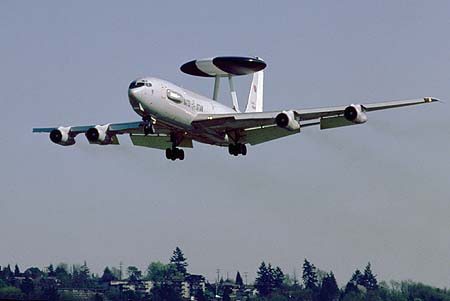China’s military on Thursday told the United States to end air and naval surveillance near its borders, saying it was damaging relations between the Pacific powers and could lead to “undesirable accidents”.
The US should “take concrete measures to decrease close-in reconnaissance activities against China towards a complete stop”, defence ministry spokesman Yang Yujun said at a monthly briefing.
Yang’s comments came with Beijing and Washington at odds over an incident last week in the skies 220 kilometres (135 miles) off China’s Hainan island.
The US said that an armed Chinese fighter jet flew dangerously close to a US military aircraft, while China countered in a ministry statement carried on state media that the allegations were “totally groundless”.
“The location of the incident is 220 kilometres from China’s Hainan island,” Yang said Thursday. “It is not 220 kilometres from Hawaii in the United States and certainly not 220 kilometres from Florida. So the rights and wrongs of this case are very clear.”
The encounter has raised comparisons to an incident in April 2001, when a Chinese fighter jet collided with a US Navy EP-3 spy plane around 110 kilometres off Hainan.
One Chinese pilot died and the US plane had to make an emergency landing on Hainan where China detained the 24-member crew for more than a week until Beijing and Washington cut a deal for their release.
In the ensuing years China’s military spending and capabilities have increased while the US military, long a presence in the region, has strengthened its defence alliance with Tokyo, which is at odds with Beijing over disputed islands in the East China Sea.
Yang said US ships and aircraft had long been engaged in “frequent, wide-range, close-in reconnaissance activities against China”.
Such missions “not only damage China’s security interests but also damage strategic trust and the bilateral relationship between China and the United States”.
They could also “possibly lead to undesirable accidents”, he said.
The two militaries have been stepping up exchanges and visits in an effort to build trust and try to work out guidelines to avoid miscalculations as they increasingly encounter each other at air and sea.
– ‘Act of hostility’ –
Regarding just such a scheduled meeting under way this week in Washington, Yang offered no details, citing the ongoing nature of the talks.
China’s Global Times newspaper, which is linked to the ruling Communist Party, on Monday warned that Beijing could treat US surveillance flights as an “act of hostility”.
On Thursday it said that if the US does not end them, China could carry out similar activities near US territory.
Such an “option has become increasingly possible as China’s military technologies are advancing”, it said in an editorial.
Yang, when asked directly about such a possibility, gave an ambiguous answer.
“As to what missions PLA ships and aircraft will take in the future, that will be decided based on various factors,” he said, using the abbreviation for the People’s Liberation Army, China’s military.
China lacks the kind of forward bases in the Western Hemisphere that Washington has in the Asia-Pacific, such as in Hawaii, Guam, Japan and South Korea, making any such reconnaissance operations against the US far more difficult.
Separately, Taiwan said on Tuesday that its air force scrambled fighter jets the day before to track two Chinese Y-8 maritime patrol aircraft it claimed intruded into the island’s air defence zone and followed them until they departed.
Asked about the incident, Yang would only say that Chinese planes “conducted routine flights in related air space” on Monday.
“No abnormal situation occurred,” he added.
Yang also defended the professionalism of China’s air force against accusations of aggressiveness and recklessness, saying its pilots have “given due regard” to matters of safety.
“Our aircraft are very precious and the lives of our pilots are even more precious compared with countries which ask their pilots to fly around on other countries’ doorsteps,” he said, an apparent reference to the US.










